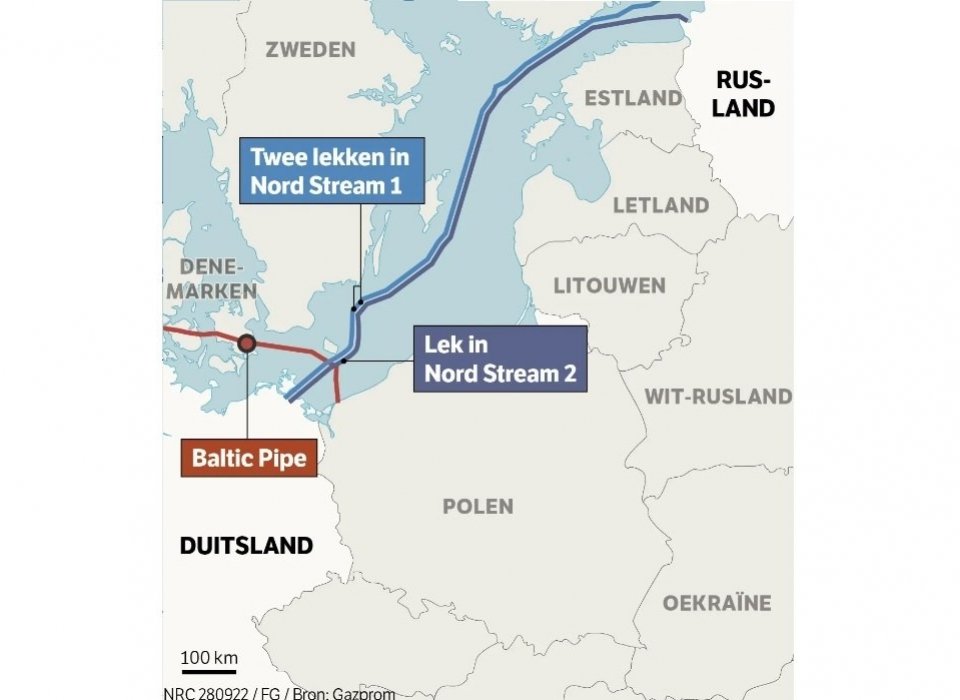The Friday Edition
Explosions at Nord Stream 'can only be attacks'
Source: NRC
Published September 27, 2022
The powerful explosions measured Monday along the gas pipeline Nord Stream 1 and 2 could be a message from Russia, analysts think. "To show what it is capable of."

Like an Earthquake with a Magnitude of 2.3 on the Richter Scale
For example, monitoring stations in Sweden registered explosions at the bottom of the Baltic Sea on the Danish Island of Bornholm on Monday evening. There is no doubt that they were explosions: they punched holes in the two Nord Stream gas pipelines that play a crucial role in the energy chess game between Russia and Europe surrounding the war in Ukraine.
No gas flows through the pipes. Russia has shut down Nord Stream-1 on the pretext that Western sanctions are blocking a significant repair. And Germany refused to give Nord Stream 2 the green light just before the Russian invasion of Ukraine. Nevertheless, there are hundreds of millions of cubic meters of natural gas in both pipelines, which are released. Gas prices skyrocketed.
"Our imagination no longer allows for a scenario where this is not a targeted attack," a German government official told Tagesspiegel on Tuesday. Poland and Denmark also assumed sabotage; it underlines the vulnerability of energy infrastructure. Denmark and Norway have tightened security measures around energy nodes.
Such an attack, which goes beyond using gas as a political weapon, carries all the elements of 'hybrid warfare.'
There is wild speculation about the perpetrator and motive. But the timing was salient: one day before the opening of Baltic Pipe, the new gas connection from Norway via Denmark to Poland. Danish Prime Minister Mette Frederiksen was in Poland for the opening ceremony on Tuesday.
Norwegian gas must compensate for missing Russian gas. "The leak in Nordstream-2 [southeast of Bornholm] is close to the Baltic Pipe," Tom Marzec-Manser, an energy consultant, told the Financial Times. "Norwegian gas means a new dawn for European imports, but twilight for Russia."
Negotiation Room
Aslak Berg, a Norwegian economist, said on Twitter that he saw only two possibilities: a scenario in which "a friendly nation carried out the attack" to prevent Germany from having a "negotiating room with Russia" over gas. And two: Russia did it "to show what it is capable of." "If the gas supply from Norway is interrupted, everything will be in jeopardy," Berg said.
The latter also seems plausible to Julian Pawlak, a German defense analyst. The goal is to "send a message," he tweeted. "Anyone who can paralyze a pipeline through which no gas flows can also hit active infrastructure." Such as oil and gas pipelines that lie all over the North and Baltic Seas or power cables to offshore wind farms and data cables, which form the backbone of the interconnected economies.
There is no doubt that Russia is capable of such operations. It features submarines, human-crewed and crewless "underwater vehicles," and so-called combat divers. Russian ships have also been repeatedly found performing suspicious maneuvers at submarine cables. Cutting a data link between Norway and a satellite station on Spitsbergen early this year was almost certainly the work of Russia. With the Belgorod, a 'submarine mothership,' Russia has a specially equipped vessel for this.
But it is precisely the shallow Baltic Sea is being closely observed by "adjacent countries and their navies," according to H.I. Sutton, an authoritative maritime analyst. It is virtually impossible that the Belgorod (with a length of more than 150 meters) "could operate unnoticed there," said Sutton.
Dutch Tanker Plane
Significantly since the Russian invasion of Ukraine, surveillance has been sharpened enormously. ADS-B Exchange, an open-source aircraft movement tracker, showed Western military aircraft patrolling the Baltic Sea on Tuesday. Even what you did not see was significant: above the area of the explosions, a military tank plane registered in the Netherlands circled for hours. But the plane that was supposed to refuel the A330 in the air — almost certainly a military aircraft capable of detecting underwater activity — was not visible because it had its electronic beacon turned off.
LATEST OPEN LETTERS
-
21-07Freedom
-
20-03Stand up to Trump
-
18-02Average Americans Response
-
23-12Tens of thousands of dead children.......this must stop
-
05-06A Call to Action: Uniting for a Lasting Peace in the Holy Land
-
28-05Concerned world citizen
-
13-02World Peace
-
05-12My scream to the world
-
16-11To Syria and Bashar al-Assad
-
16-11To Palestine
VIRTUAL POST OFFICE
PETITIONS
LINKS
DONATION
Latest Blog Articles
-
17-12Our Wednesday News Analysis | Gaza and the unravelling of a world order built on power
-
16-12Gaza and the unravelling of a world order built on power
-
16-12US plan in Gaza: forced ghettoisation, annexation, mass detention, resource plunder
-
16-12Von der Leyen and Blair still want to boss Palestinians around
-
15-12The Evangelical Pope | The Universal Value of Life
-
11-12Our Friday News Analysis | What the World Reads Now!
-
10-12Our Wednesday News Analysis | A story of a 1930s uprising against British colonialism is key to understanding Gaza today
-
09-12A story of a 1930s uprising against British colonialism is key to understanding Gaza today
-
09-12Netanyahu rules out creation of Palestinian state
-
09-12Israel has shown how to carry out a genocide and get away with it
-
08-12The Evangelical Pope | Humility – the Power of Truth and Love
Latest Comments
 One of the most important and illuminating articles that I …
One of the most important and illuminating articles that I …
Comment by Benjamin Inbaraj And what's wrong here?
After all, there is the homeland …
And what's wrong here?
After all, there is the homeland …
Comment by Isac Boian Does this reinforce or deny my argument that Israel is …
Does this reinforce or deny my argument that Israel is …
Comment by Edward Campbell Many 'say' they support the Palestinian cause but do little …
Many 'say' they support the Palestinian cause but do little …
Comment by Philip McFedries The UN is strangled by the "war for profit" cabal …
The UN is strangled by the "war for profit" cabal …
Comment by Philip McFedries I can't read the printing on the map.
I can't read the printing on the map.
Comment by Philip McFedries Good news!
Good news!
Comment by Philip McFedries

COMMENTS
This article has 0 comments at this time. We invoke you to participate the discussion and leave your comment below. Share your opinion and let the world know.